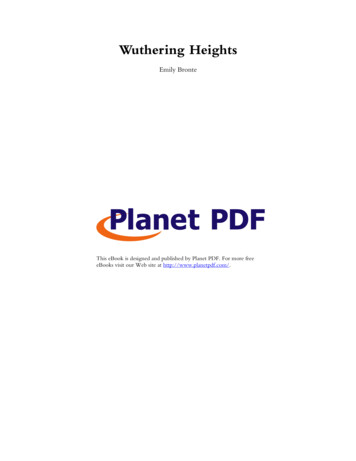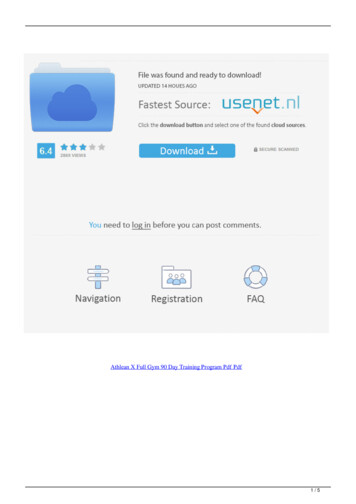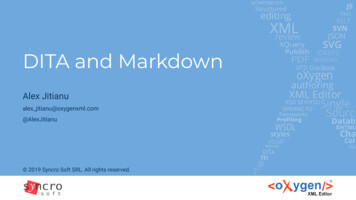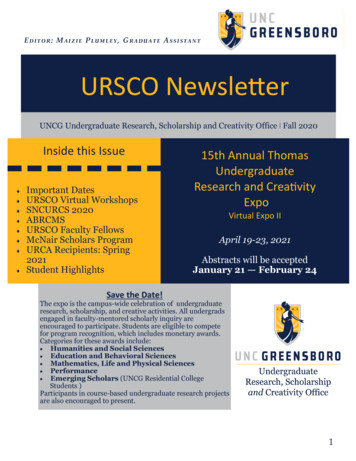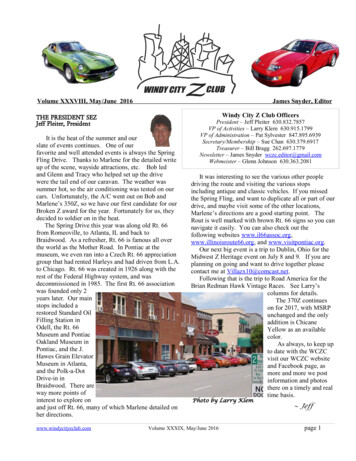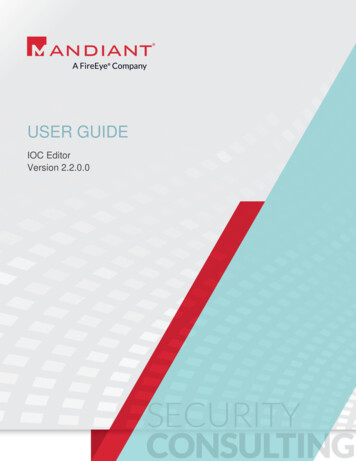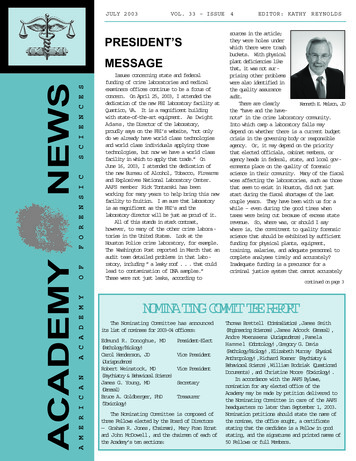
Transcription
ToolsndrariteeWFrewithorditPDFEFillPDISBN 978-965-7523-08-7ISBN 978-965-7523-08-79 789657 5230879 789657 523087
All of the Above:Identity Paradoxesof Young People in IsraelThe 3rd Youth Study of the Friedrich-Ebert-StiftungChanges in National, Societal, and Personal AttitudesPublished by: Dr. Ralf Hexel and Dr. Roby NathansonEditor: Hagar Tzameret-KertcherResearchers: Prof. Eppie Ya'ar, Dr. Mina Zemach, Dr. Taghreed Yahia-Younis, DahliaScheindlin, Yasmin Alkalai, Ziv RubinCommentators: MK Isaac Herzog, Minister, MK Michael Eitan, Minister, MK Shlomo Molla,David Hadari, Sha’anan Street, Ibtisam Mara'ana, Prof. Bernard Avishai, Prof. Natan Sznaider,Prof. Mathias Albert, Boris ZaidmanTranslator: Sandy Bloom20101
All Copyrights belong to the Friedrich-Ebert-Stiftung. The authors are thesole responsible for the contents of the articles which do not reflect theopinion of the editors or the Friedrich-Ebert-Stiftung. 2010 by Friedrich-Ebert-Stiftung, Israel officeand Macro Center for Political EconomicsCover by Assaf Ben-Ari, assaf-ba@bezeqint.netFriedrich-Ebert-Stiftungp.o box 12235Herzliya 46733 IsraelTel. 972-9-9514760E-Mail fes@fes.org.ilISBN 978-965-7523-08-7Printed in Israel2
ContentIntroduction Dr. Ralf Hexel5Part One: Analysis of FindingsChapter 1 Preface and Summary11Chapter 2 Attitude Survey Results: Social-Political Identitiesof Israeli Youth Dr. Mina Zemach31Chapter 3 Political and Social Attitudes of Israeli Youth:Trends over Time Prof. Eppie Ya'ar and Yasmin Alkalai121Chapter 4 Israeli Youth - Where Are They Headed? Analysis of PoliticalTrends Based on a Quantitative Research Study Dahlia Scheindlin218Chapter 5 Social and Political Viewpoints and Attitudes ofArab-Palestinian Youth in Israel Dr. Taghreed Yahia-Younis245Chapter 6 Face to Face: Interviews with Adolescents and YoungAdults in Israel Dr. Mina Tzemach281Part Two: Commentary on Youth in IsraelChapter 7 Response to the Report on the Identity of Israeli Youth, 2010,with a Focus on Youth at Risk MK Isaac (Buji) Herzog, Minister347Chapter 8 The Young Generation’s Vision: What Kind of CountryWould They Like Israel to Be? MK Michael Eitan, MinisterChapter 9 Attitudes and Identity of Ethiopian Youth in Israel MK Shlomo Molla355363Chapter 10 Youth at Performances of "Hadag Nahash":The Law of Conservation of Energy Sha’anan Streett368Chapter 11 Young Arab Women in Israel: The Impossible Integrationof Gender and Ethnicity Ibtisam Mara’ana3753
Chapter 12 Isra-Russian Youth: Post-Israeli Nationalismor Post-Jewish Zionism? Boris Zaidman382Chapter 13 "The Smallest Shall Become a Thousand,and the Least a Mighty Nation" (Isaiah 60:22) David Hadari390Chapter 14 Young People in Israel - 2010:Comments on a conducted survey Prof. Natan Sznaider400Chapter 15 American Jews and the Attitudesof Young Israelis Prof. Bernard Avishai407Chapter 16 Israeli Youth, 2010: Refractions through the Prism of theGerman Shell Youth Study, 2010 Prof. Mathias Albert416Part Three: Background Information and DemographicsChapter 17 Periodic Demographic Data about Israeli Youth Ziv Rubin425About the Authors4434
IntroductionThe 2010 Youth Study of the Friedrich-Ebert-Stiftung constitutes the thirdsurvey conducted by the Foundation in collaboration with the Macro Centerfor Political Economics. Its purpose was to examine the attitudes andideological perceptions of adolescents and young adults in Israel. Theimpetus for the first study was the occasion of Israel's fiftieth IndependenceDay in 1998. The second survey of the series took place in 2004, in the verymidst of the Second Intifada, and the third and final one took place in 2010.Thus the results of the third survey, in this book that appears before you,enable us to examine changes and trends that took place over twelve years inthe attitudes and ideological perceptions of Israeli youth. All three surveyspolled members of the same age groups and asked questions that belonged tothe same subject groupings: the situation and status of Israel in general, thepersonal expectations of the respondents regarding their futures and personalhappiness, and their attitudes toward the following issues: Zionism, theState's democracy and institutions, minorities in Israel, the Israeli-Palestinianconflict, Germany and the Holocaust. For the first time, in-depth interviewswere conducted with 80 youths in the 2010 Youth Study to complement thesurvey and provide a more profound understanding of its findings.The main goals of Friedrich-Ebert-Stiftung activities involve strengtheningof democracy and encouraging the active involvement of citizens in moldingpolitics and society. To promote these goals, the Foundation is assisted by itsrepresentatives in Israel (since 1978). The Friedrich-Ebert-Stiftung uses abroad variety of methods and resources such as conventions and workshops,international dialogue programs, publications, training courses, researchstudies and surveys. In its activities, the Foundation places an emphasis ontraining adolescents and young adults and providing them with the5
knowledge, educational, and discussion skills they need in order to to takepart in social and political processes while expressing their aspirations andattitudes.The results of the study in front of us document the reality of the lives ofyouth who face a world that lacks security and clarity. Their attitudes andvalues are influenced by life in the State of Israel: after 62 years of existence,Israel still feels threatened by its neighbors and is far from making peace withthe Palestinians and Arabs in general. To this mix we add the financial andgeneral global crisis of 2008-2009, as well as the challenges that accompanyclimate changes and globalization. All these serve to demonstrate just howlimited is the scope of the nation-state and its institutions, with regards tospheres of action and influence. Thus we ask: What can youth rely on, in ourday and age? What can possibly inspire them? Where will they find stabilityand security? Who can serve as role-models in the formative years of theirlives? Their values, attitudes and identities are fashioned when they wrestlewith these questions and others.From the youths' points of view we can extrapolate how our society islikely to look in the not-too-distant future. These viewpoints serve asseismographs for societal changes and future developments. The third youthsurvey (2010) of the Friedrich-Ebert-Stiftung shows that our youth lex,contradiction-laden world. In general, they have created a basic pattern of"All of the above": this worldview does not resolve the contradictions in theirperceptions of reality, but integrates them into their personal attitudes.Basically, while the youth are in favor of peace with the Palestinians, manyreject compromises in the peace process and prefer the status quo. They viewdemocracy as an important basic value, yet about half would prefer that ArabIsraelis were not represented in the Knesset. The complex and emotionallycharged circumstances of their country do not arouse their general fear orapathy. Instead, the youth display robustly positive, optimistic attitudesvis-á-vis everything connected to their hopes for the future and their personalwelfare, future marital partner, family and profession.Their attitude toward politics and politicians is patently negative. This trendwas accompanied by a progressive decrease in trust in liberal-democratic6
values and government institutions; simultaneously, Jewish-national outlooksprogressively increased. According to religious youth, mainly haredi ones,the Jewish nature of the State and society are significantly more importantthan democracy. With regards to the Israeli-Palestinian conflict: theconventional wisdom among Jewish youth is that the Arabs do notacknowledge the existence of the State of Israel and if they had theopportunity, they would destroy it.The attitudes of the young Arabs are very different than those of theirJewish contemporaries. They feel that acquiring a higher education is ofgreatest importance; they, like minority groups in other societies, vieweducation as the springboard to social advancement and economic welfare.At the same time, the young Arabs feel that they are not sufficientlyintegrated into Israeli society. They exhibit worrisome levels of alienation,especially in the in-depth interviews that were conducted.These attitudes of youth in Israel do not portend well for the chances ofpeace-making between Israel and its Arab neighbors. With regard to Israel'sfuture as a democratic and pluralistic society, the attitudes described aboverepresent a major challenge to those social and political agents who arecommitted to the values and goals of the founding fathers of the State of Israel.Israeli youth of 2010 evinced more interest in the Holocaust than did theircorresponding age-group in 1998. While 68% of youths in 1998 said theywere personally interested in the Holocaust, that figure went up to 81%twelve years later, in 2010. Thus it seems that the Holocaust has become animportant unifying force in Israeli society. It should be noted that thisHolocaust interest is not directly connected to modern-day Germany. Whilethe youth are aware of the role played by the Germans in the genocide,today's Germany is generally viewed as a different country, one that isfriendly to Israel.Yet, though the attitudes of Israeli youth vis-á-vis Germany haveundergone a significant improvement since 1998, the Friedrich-Ebert-Stiftunghas no intentions of attempting to sideline the Holocaust memory in itsactivities. As expressed by Germany's former president Johannes Rau, in hisspeech to the Knesset in 2000 - it is important that lessons from the pastcontinue to serve as the firm basis of the mutual shaping of the future.7
The study in front of us is composed of two parts. In the first part,well-known researchers and pollsters (including Professor Eppie Ya'ar)analyze the findings of the survey conducted by the Dahaf Institute under Dr.Minah Zemach. In the second part, the survey results are explicated andelucidated by salient representatives of politics, society and culturallife-including ministers Isaac Herzog and Michael Eitan, and MK ShlomoMolla. Other voices who contribute authentic information about the innerlives of young Israelis and also interpret the survey results include pop singerSha'anan Streett, movie producer Ibtisam Mara'ana, and author BorisZaidman. Sociology Professor Natan Sznaider analyzes the results from abroad perspective. The American journalist Professor Bernard Avishai andco-author of the German Youth Study Mathias Albert place the results of thesurvey in the international context.I would like to take this opportunity to thank all those who were involvedin preparing and conducting this survey. I convey special thanks to ourpublisher partner, Dr. Roby Nathanson, and the book's editor, HagarTzameret-Kertcher as well as the entire staff of the Macro Center for PoliticalEconomics for their outstanding cooperation. I would also like to thank Dr.Mina Zemach and Professor Eppie Ya'ar who contributed a great deal to thisproject from the wealth of their experience and expertise in the field ofopinion polls, and Dr. Taghreed Yahia-Younis and Dahlia Scheindlin fortheir important contribution to the analysis of the survey results.The survey data was not included in this volume. They may be viewed onthe Friedrich-Ebert-Stiftung in Israel website (www.fes.org.il) and the MacroCenter for Political Economics website (www.macro.org.il).Finally, I would like to make it clear that the opinions presented in thevarious analyses and commentaries do not necessarily reflect the attitudes ofthe Friedrich-Ebert-Stiftung and the Macro Center for Political Economics,but only the personal opinions of the writers and analysts themselves.Dr. Ralf Hexel,Representative of theFriedrich-Ebert-Stiftung in Israel8
Part OneAnalysis of Findings9
עמ' 10 ריק 10
Chapter 1Preface and SummaryIntroductionThe large quantity and scope of research material found in the volume youhold in your hands does not allow us to present our work in a short, thoroughsummary that lists all the results and analyses. The results that appear herereflect complexities and contradictions; to a certain extent, these ambiguitiesexpress the reality of the lives of youth everywhere. Young people all overthe world grapple with the need to define their own identities and find cleardirection in life. They are forced to do this at an age in which both 'identity'and 'direction' are hard to come by, in a global post-modern world in whichmore and more once-accepted truths are being shattered. From the day theywere born, the daily lives of young people in our generation are full ofchanges: changes in social orders, in national and gender identities, and intechnology-as well as instability in the employment world. In contrast to us,the adults, the world around them does not offer them the vision of a clearlife trajectory, predictable and foretold. What do they have to say about thedichotomous patterns and categories that we created in the "stable" world inwhich we grew up: Left or Right, Jewish state or democratic state?Privatization, or welfare support of the poor? The results of the presentsurvey show that, in the hands of our youth, these categories fall apart;instead they create a unified picture composed of the fragments. The"either-or" gives way to "as well as" (as Natan Sznaider writes in hischapter), or what we also call "all of the above." The old categories still exist,but not dichotomously. We have been tracking these changes in our researchsince the earlier surveys of 1998 and 2004, and now, in this book, we address2010 as well.11
Background of the StudyThis study was conducted in order to understand what young Israelis (aged15-18 and 21-24) think. The research spheres were meticulously selectedand in general,
PDFill PDF Editor with Free Writer and Tools. 1. All of the Above: Identity Paradoxes . of Young People in Israel. The 3rd Youth Study of the Friedrich-Ebert-Stiftung . Changes in National, Societal, and Personal Attitudes. Published by: Dr. Ralf Hexel and Dr. Roby Nathanson. Editor: Hagar Tzameret -Kertcher . Researchers: Prof. EppieYa'ar, Dr. Mina Zemach, Dr. Taghreed Yahia -Younis, Dahlia .

